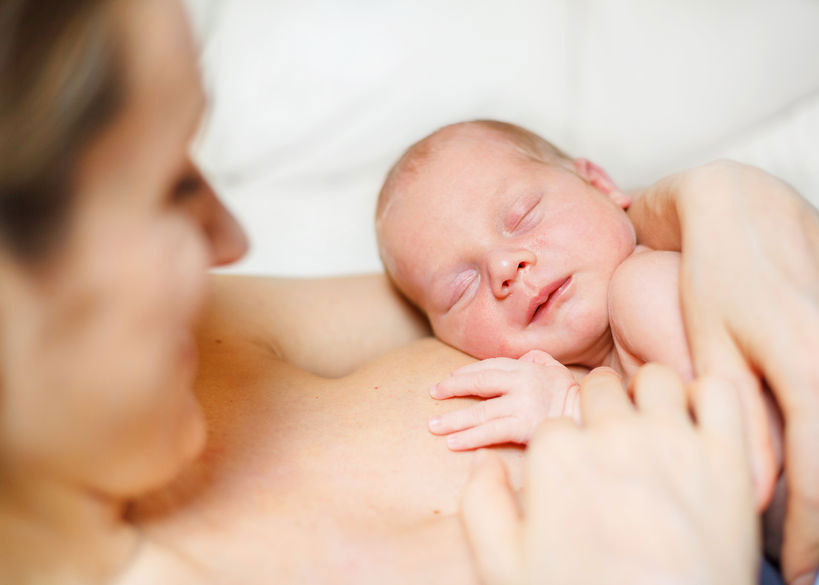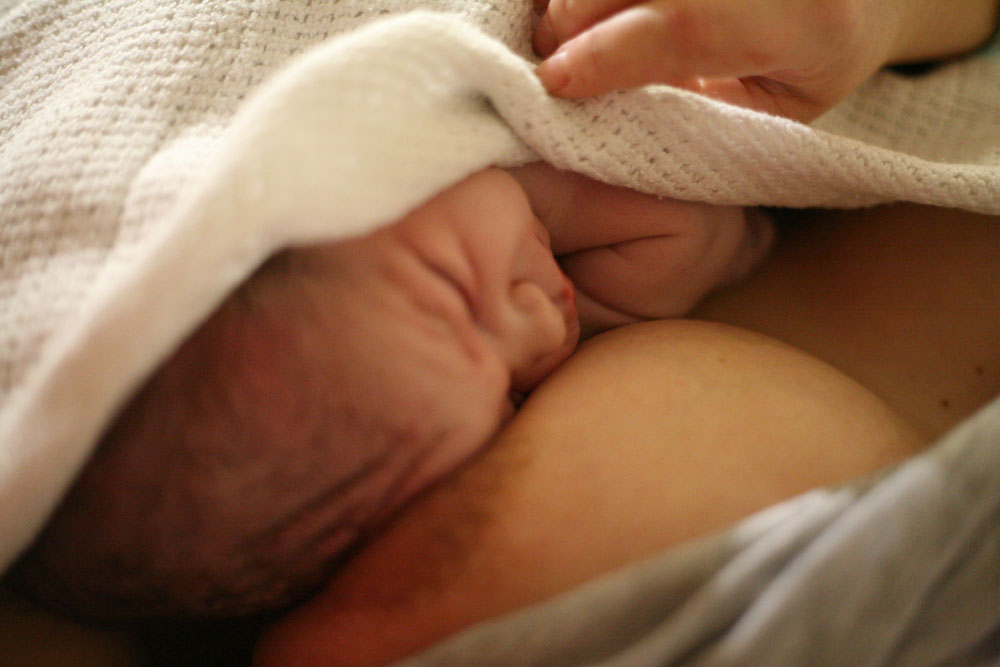Holding your baby skin-to-skin both straight after birth—and later in the weeks to follow—has amazing benefits for you and your baby.
Good for baby
Studies have shown that placed skin-to-skin on mother’s chest after birth (or father’s if mother isn’t available), a baby has:
- better oxygen levels and better breathing
- a better regulated temperature and heart rate
- less crying—he feels safe
- lower stress hormone (serum cortisol)
- better sleep—which helps brain development
- more stable blood glucose levels
- more self-latching (when baby attaches to the breast unaided)
- better co-ordinated suckling
- better weight gain
- colonisation with his mother’s skin flora (a good thing!)
Skin-to-skin helps breastfeeding and weight gain
Many early difficulties with latch or poor weight gain can be helped by spending more time holding your baby skin-to-skin or lightly dressed… at any time in the early weeks. In slightly laid back or reclining positions a baby can feel his tummy against his mother’s body, and this helps him to use his natural instincts and feeding reflexes to latch deeply and comfortably (see video clips below). If the room temperature is not very warm, both mother and baby can be covered with a blanket. When warm, safe and content on your body, babies don’t have to use excess energy for maintaining their own temperature, keeping their body systems stable or crying for attention—and they can use more of their energy to grow and gain weight.
Take off anti-scratch mittens
Letting your baby use his hands to feel your skin is important to help him find, feel, and shape the breast1 so take off any anti-scratch mittens. And most babies won’t need a hat when they are in skin-to-skin contact 2.
Skin-to-skin for the premature baby
Skin-to-skin or kangaroo care—where baby is held in skin contact for long periods—can be especially beneficial to the premature baby. See Kangaroo Care for Your Premature Baby for much more information.

Good for mum
For mum, holding her baby skin-to-skin will help bonding, stimulate her mothering instincts and intuition, and help increase her confidence as a mother. Skin-to-skin contact releases prolactin and stimulates oxytocin (special hormones) which help with milk production. The senses of smell, sight, touch, taste and hearing will all be stimulated in skin-to-skin which have very positive calming effects on both mother and baby.
Separation
Separating a mother from her baby can have many subtle undesirable effects for a newborn. Nils and Jill Bergman have a great website (kangaroomothercare.com) with lots of information on both the harms of separating mother and baby and the benefits of skin-to-skin contact. In the excerpt below Jill Bergman describes how stress hormones affect a baby when he is separated from his mother:
Separation from mother is highly stressful, and is enough to make a baby physiologically unstable. He feels unsafe, his brain sends “danger” signals to the body. His brain releases the stress hormone cortisol, which increases the heart rate and breathing in a basic “fight or flight” reaction. Somatostatin is also released and acts in the gut to decrease absorption of food and thus inhibit growth. These stress hormones will continue to affect the baby while he is separated from mom. When returned to his mother, the stress hormones still take 30 minutes or even an hour to wash out of his system.
The separated baby will protest and cry to call for mom. His arms and legs will wave or jerk to get his mother to come back. The crying can also open the foramen ovale, a flap between the two sides of the heart, thus restoring fetal circulation, which now pumps deoxygenated blood to the brain. This crying increases the heart rate and blood pressure in the baby’s brain, which can damage the tiny capillaries, maybe even causing an intraventricular hemorrhage (IVH).
The rest of the article has many more fascinating facts about the value of skin-to-skin and early breastfeeding. For example the hormones involved in milk production also have important roles for a baby’s development. Prolactin is involved in nerve cell formation and production of a substance that helps the newborn baby’s lungs to breathe better. Oxytocin doubles as a messenger in the brain while another chemical (cholecystokinin) in the milk calms the baby and helps him to self-regulate his digestion.
Self-latching and breast crawl
Giving your baby the opportunity of crawling to the breast themselves after birth while in skin-to-skin contact has been shown to be very beneficial for mother, baby and breastfeeding. When your baby is on his tummy (prone), his feeding reflexes and his hands help him move towards the breast, find the nipple and prepare him for instinctive latching. This can be repeated at any time in the early weeks not just immediately after the birth.
Skin-to-skin as soon as possible
The following video from the Global Health Media Project shows babies finding the nipple and self-latching in skin-to-skin contact just after birth (see 3:15, 5:42, 7:25 and 8:20). The clip summarises how to get breastfeeding off to a good start with early skin-to-skin contact:
- Place baby skin-to-skin with his mother straight after the birth
- Do not wash mother’s nipples or dry baby’s hands
- Keep mother and baby together undisturbed after the birth
Baby-led attachment
In this second clip from raisingchildren.net.au, a mother demonstrates sitting in a semi-reclining (or laid back) position, with her baby in skin-to-skin contact in her arms. In this video the baby latches on herself without help from her mother at 4:08, the video clip refers to this as “baby-led attachment”.
Breast crawl
In the famous clip below from breastcrawl.org, a newborn baby is placed between her mother’s breasts and finds the nipple herself at 4:55. In normal circumstances you won’t have a film crew and medical staff around you… or be lying completely flat. Lying at a 45º angle will allow you to see your baby and help them with the breast crawl (see second clip above).
Help with latching
If you are finding it difficult to latch your baby comfortably and are finding breastfeeding painful or have sore nipples, work with an IBCLC lactation consultant to find the best position for you and your baby and see our Latching Tips.
Summary
Holding a baby skin-to-skin has many benefits for mothers and babies including helping breastfeeding get established. If mother isn’t available, the baby’s father or a loving family member will be a great alternative.

